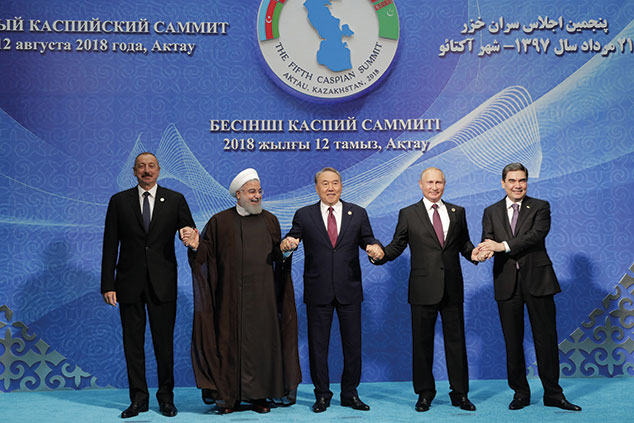
What’s happened?
Last month leaders of the five countries on the Caspian Sea – Russia, Iran, Kazakhstan, Turkmenistan and Azerbaijan – gathered in the Kazakh city of Aktau to sign the Convention on the Legal Status of the Caspian Sea. The deal provides a framework for grappling with disputes about mineral rights and has been hailed as a “regional constitution” by diplomats.
The Caspian is the world’s biggest inland body of water. Larger than Germany at 371,000 square kilometres, it contains 48 billion barrels of oil and around eight trillion cubic metres of gas, reckons the US Energy Information Administration. The Caspian Sea’s natural gas reserves are similar to Saudi Arabia’s. Yet for two decades many of those energy resources have not been tapped owing to territorial disputes and arguments over how to classify the Caspian.
So is it a sea or a lake?
That is the trillion-dollar question. As an inland body of water, the Caspian was long treated as a lake by the Soviet Union and Iran, but the dissolution of the communist superpower and the independence of Kazakhstan, Turkmenistan and Azerbaijan in 1991 complicated matters.
The question of whether it is a sea or a lake has important implications for how its vast mineral wealth – worth trillions of US dollars – is divided up. “Seas” are governed by the UN Law of the Sea and mineral rights are apportioned according to the size and proximity of coastlines. Lakes are usually divided evenly between states.
Iran, which has the smallest Caspian coastline, has long insisted that the body of water is a lake, but its northern neighbours, who stand to gain from a “sea” classification, beg to differ. There are arguments in favour of both views. The Caspian is salty, for example, but only has one-third the salinity of ocean water. Its surface sits 28 metres lower than global sea levels.
What does the Convention say?
The Convention has fudged the issue, effectively treating the surface of the Caspian as a sea, but leaving the apportionment of the bed up to bilateral negotiations between claimants. The body of water has a “special legal status”, according to the Convention.
The northern boundaries of the seabed are more or less agreed, but the same cannot be said for the southern half, leaving Tehran with some tough negotiating to do. Iran is widely thought to have lost out from this accord by giving up its pro-lake position, a move which could see it go from a 20% claim on the seabed to about 11%.
Iran is currently contending with the economic impact of new US sanctions, as Iranian political analyst Amir Taheri points out in Deutsche Welle. The fact that it “agreed to this deal [highlights] Tehran’s current weak geopolitical position”.
Who benefits from the accord?
The Convention permits common access to the Caspian among the five littoral states, but bans the presence of military vessels from outside the Caspian five. That part of the deal is widely considered a victory for Russia, the predominant military power in the region. Moscow uses the Caspian to station warships involved in the Syrian conflict; it will be glad that the treaty enables it to fend off potential encroachment from both Nato and Xi Jinping’s ambitious “Belt and Road” initiative to the east. This $900bn Chinese infrastructure plan, billed as a “New Silk Road”, threatens to spread Beijing’s economic influence through central Asia and the ex-Soviet Union.
Is it all good news for Moscow?
One of Russia’s biggest strategic interests in the Caspian is to prevent the laying of a pipeline between Turkmenistan and Azerbaijan – the ‘Trans-Caspian project’– which would allow European consumers access to Turkmenistan’s vast gas reserves without the need for them to pass through Russia or Iran. The pipeline would cost around $5bn and transport 30 billion cubic metres of gas every year; Turkmenistan’s current production is around 75 billion. Moscow has long opposed the pipeline – ostensibly on environmental grounds – but Article 14 of the Convention could open a legal route for it to be laid over its objections.
“The decision to agree to that trade-off reflects Russia’s strong position in European gas markets, which can survive some new competition from Turkmenistan,” says Ed Crooks in the Financial Times. Russian state-owned firm Gazprom supplies almost 40% of Europe’s gas supply, with deliveries hitting a record high last year despite European efforts to diversify supply. Moscow can also see that the pipeline is unlikely to be built in the near future.
A recent paper from the Oxford Institute for Energy Studies suggests that the economics of the proposed Turkmen gas route would “remain problematic, even if all the political issues were resolved”. Low energy prices, the rise of liquefied natural gas (LNG) shipping from the likes of Qatar and Turkmenistan’s desire to sell supplies to China too are all reasons to doubt the pipeline’s viability.
Will oil and gas drilling increase quickly?
“The convention has little material impact on prospects for oil and gas developments in the Caspian,” Will Scargill of GlobalData, a consultancy, told Forbes. Oil and gas production in the region is set to climb over the next five years, but the fossil fuels will “come from undisputed areas” already being developed.
Meanwhile, Russia’s leaders will be cheered by a deal reinforcing Moscow’s status as a key player in central Asia. “In the early 20th century, British geographer Halford Mackinder argued that the country in control of the ‘heartland’ of Eurasia, mainly central Asia, had the potential to rule the region and the world,” says Naubet Bisenov in Nikkei Asian Review. “With the global order now in flux, the struggle for the heartland is heating up again.”